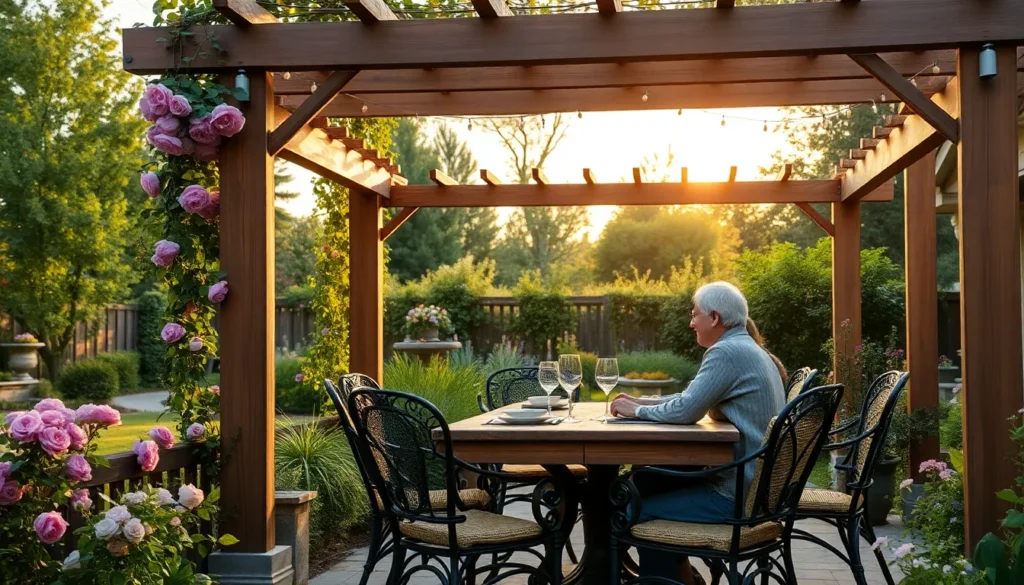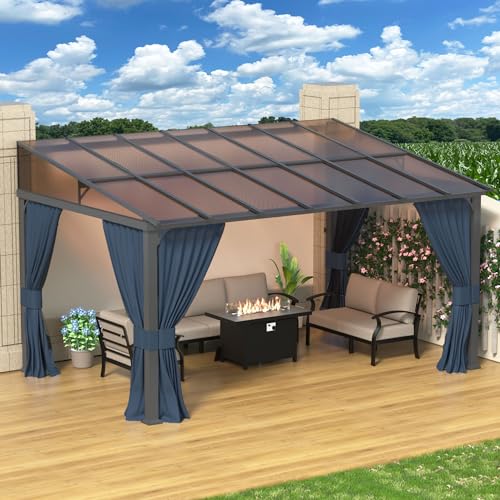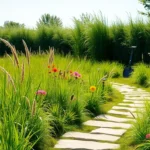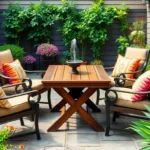Looking to transform your outdoor space into a stunning retreat? Garden pergolas have become one of the most sought-after industry features for homeowners who want to blend functionality with breathtaking beauty. These architectural elements don’t just provide shade and structure – they create magical focal points that elevate your entire garden design.
We’ve seen countless gardens transformed from ordinary to extraordinary with the right pergola placement and design choices. Whether you’re dreaming of a cozy dining area wrapped in climbing roses or a modern entertainment space with clean geometric lines, pergolas offer endless possibilities to match your style and needs.
From rustic wooden structures that complement cottage gardens to sleek metal designs perfect for contemporary spaces, we’ll explore creative ideas that’ll inspire your next outdoor project. Your garden’s potential is limitless when you discover how these versatile structures can define spaces, support climbing plants, and create the perfect backdrop for outdoor living.
Create a Romantic Garden Retreat with Climbing Roses and Pergolas
Nothing matches the timeless elegance of climbing roses cascading over a pergola structure. We’ll transform your outdoor space into an enchanting sanctuary where fragrant blooms create natural canopies and romantic ambiance throughout the growing season.
Choose the Right Rose Varieties for Your Climate
Selecting climate appropriate roses ensures your pergola garden thrives year after year. We recommend Eden roses for their disease resistance and repeat blooming characteristics in most temperate zones. Zephirine Drouhin offers thornless canes that make maintenance easier while producing fragrant pink blooms from spring through fall.
Consider your hardiness zone when choosing varieties for optimal performance. Lady Banks roses excel in warmer climates zones 7-10 and produce masses of small yellow or white flowers. New Dawn roses handle colder regions zones 5-9 beautifully with their pale pink blooms and vigorous climbing habit.
Match rose vigor to your pergola size for balanced proportions. Smaller structures work well with moderate growers like Climbing Iceberg while larger pergolas can accommodate vigorous varieties such as Climbing Don Juan. Planning for mature size prevents overcrowding and ensures proper air circulation around your plants.
Install Proper Support Systems for Heavy Blooms
Supporting climbing roses requires strategic placement of hardware and training systems. We install galvanized eye screws every 3-4 feet along pergola beams to provide adequate anchor points for wire guides. Heavy duty plant ties secure canes without cutting into stems as they grow and thicken over time.
Wire rope systems distribute weight evenly across pergola structures when roses reach full maturity. Stainless steel cable rated for 200 pounds offers durability against weather and plant weight. Position horizontal wires 18-24 inches apart to create training grids that guide rose growth patterns naturally.
Regular maintenance prevents structural damage from overgrown roses and heavy bloom loads. We prune dead canes each dormant season and redirect vigorous growth to maintain pergola integrity. Checking hardware annually ensures connections remain secure as plants establish strong root systems and increase in size.
Design Pathways That Lead to Your Pergola Focal Point
Creating defined pathways draws visitors toward your rose covered pergola while improving the overall garden experience. We use natural stone pavers set 2-3 inches apart to allow ground cover plants like thyme or moss to grow between joints. Curved pathways feel more organic and create anticipation as the pergola comes into view gradually.
Border plantings frame walkways and complement climbing roses with seasonal interest. Low growing lavender provides fragrance and purple blooms that pair beautifully with pink roses. Boxwood hedging offers year round structure while ornamental grasses add movement and texture contrast.
Lighting transforms pathways into evening destinations that showcase your pergola garden after dark. We install low voltage LED fixtures along path edges to create gentle illumination without overwhelming the romantic atmosphere. Solar pathway lights offer eco friendly options that charge during the day and automatically illuminate at dusk.
Transform Your Outdoor Dining Experience with Pergola-Covered Patios
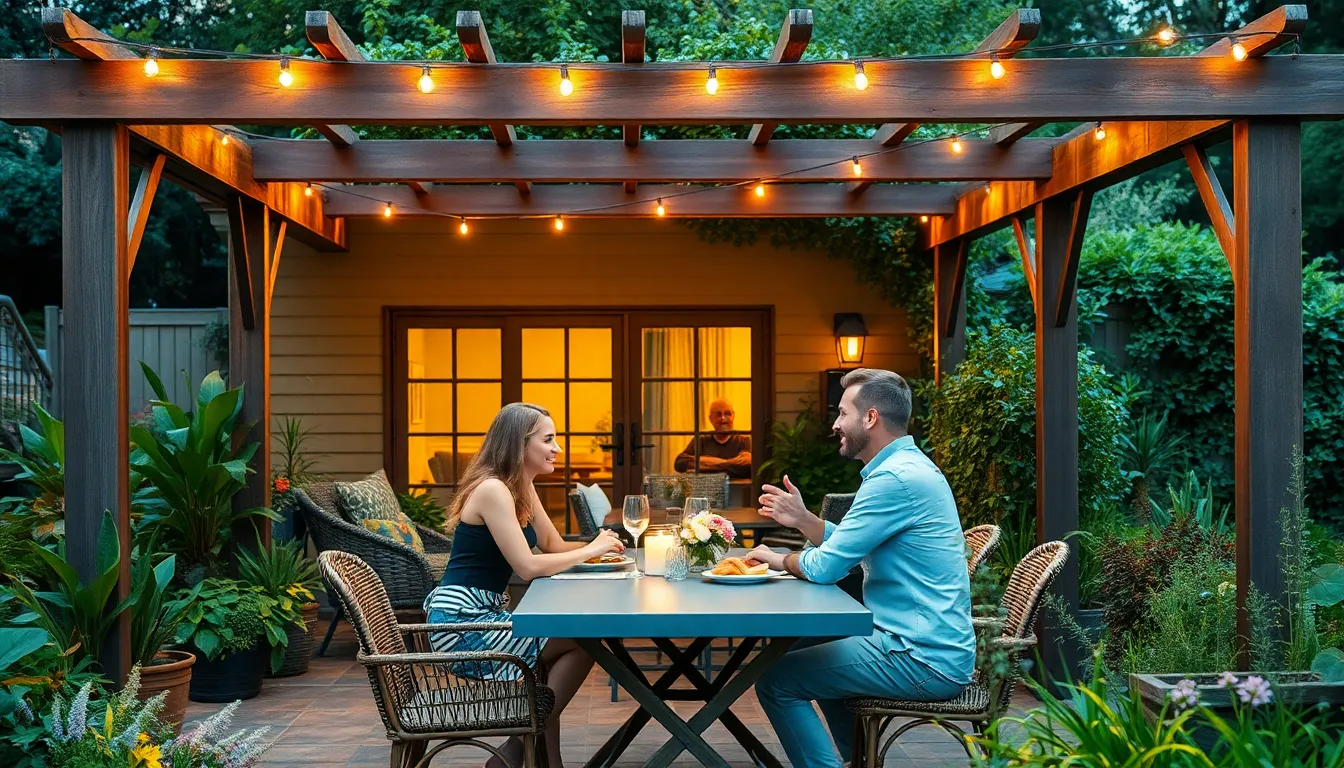
Building on your pergola garden’s romantic foundation, we can now focus on creating the perfect outdoor dining sanctuary. Pergola covered patios offer an ideal shaded area for dining, entertaining, and relaxation that seamlessly extends your home’s living space.
Select Weather-Resistant Materials for Year-Round Use
Durable materials ensure your pergola dining space withstands various weather conditions without important maintenance. Wood structures provide traditional charm but require regular upkeep, while metal and vinyl options offer superior longevity. Cedar and redwood naturally resist moisture and insects, making them excellent choices for humid climates.
Metal pergolas crafted from aluminum or steel powder coated finishes resist rust and corrosion for decades. Vinyl materials eliminate painting and staining requirements while maintaining their appearance through extreme temperature fluctuations. We recommend choosing materials that complement your home’s existing architecture while prioritizing durability over initial cost savings.
Incorporate Overhead Lighting for Evening Ambiance
String lights and fairy lights create a warm, inviting atmosphere perfect for dinner parties or romantic evenings. Edison bulb string lights provide vintage charm while LED options offer energy efficiency and longer lifespan. Pendant lights suspended from pergola beams deliver focused task lighting for food preparation and dining.
Solar powered lighting systems eliminate electrical work while providing eco friendly illumination throughout the night. Lanterns and sconces mounted on pergola posts add ambient lighting without overwhelming the space. We suggest layering different lighting types to create depth and visual interest that transforms your dining area after sunset.
Add Retractable Shade Answers for Sun Protection
Retractable systems allow you to adjust shade coverage depending on time of day and weather conditions. Fabric canopies stretch across pergola openings to block harsh afternoon sun while maintaining airflow underneath. Louvered roof systems rotate to control both sunlight and rain protection with motorized or manual operation.
Retractable awnings extend beyond the pergola structure to cover additional dining furniture when needed. Shade sails attached to pergola corners provide flexible coverage that can be removed during mild weather. We find that adjustable shade answers maximize your outdoor dining comfort throughout different seasons and times of day.
Design a Mediterranean-Inspired Garden Oasis with Stone and Vines
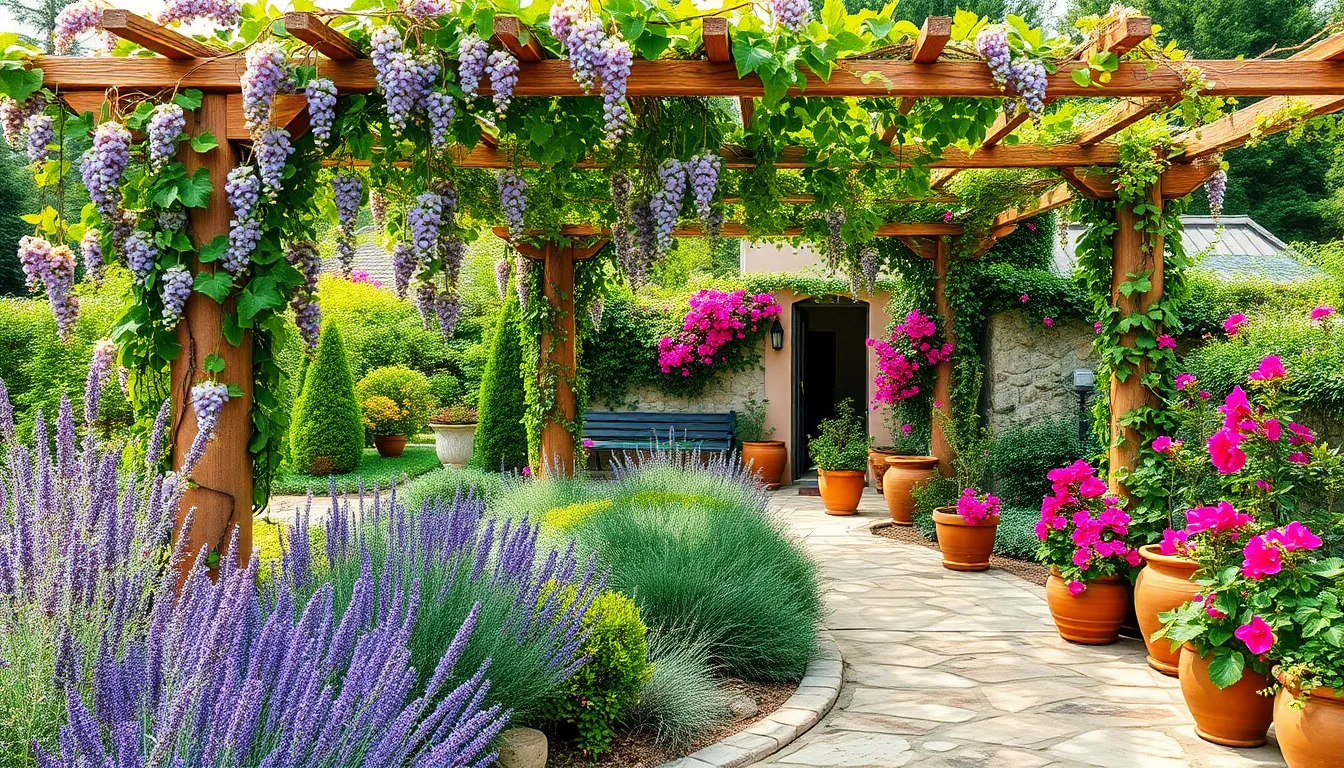
Transform your pergola garden into an authentic Mediterranean escape by incorporating natural materials and traditional plantings. This timeless design approach creates a sophisticated outdoor sanctuary that captures the essence of coastal European landscapes.
Use Natural Stone Materials for Authentic Appeal
Limestone pathways establish the foundation of your Mediterranean pergola garden with their warm, neutral tones and natural texture. Travertine offers excellent durability for high traffic areas around your pergola while providing the classic Mediterranean appearance found in Italian courtyards and Spanish patios.
Marble accents elevate the space through strategic placement in seating areas or as decorative elements beneath your pergola structure. Natural stone walls create privacy and define different garden zones while maintaining the authentic Mediterranean aesthetic that complements your pergola design.
Stone seating areas integrate seamlessly with your pergola’s footprint, offering comfortable gathering spaces that require minimal maintenance. These materials withstand weather conditions while developing a beautiful patina over time that enhances the Mediterranean character of your garden retreat.
Plant Grapevines and Mediterranean Herbs
Grapevines create natural shade coverage over your pergola while producing seasonal fruit and establishing the quintessential Mediterranean ambiance. These climbing plants require minimal water once established and provide year round visual interest through their changing foliage and architectural growth patterns.
Lavender plantings border your pergola area with their distinctive fragrance and purple blooms that attract beneficial pollinators. Rosemary bushes offer culinary benefits while contributing to the sensory experience of your garden with their aromatic evergreen foliage and delicate flowers.
Mediterranean herbs like thyme, oregano, and sage thrive in the microclimate created by your pergola’s partial shade. These plants require well draining soil and minimal irrigation, making them perfect companions for your stone hardscaping and pergola design.
Create Gravel Pathways and Terracotta Accents
Gravel walkways connect different areas of your pergola garden while providing excellent drainage and a satisfying crunch underfoot. This permeable surface material complements natural stone elements and requires minimal maintenance compared to traditional lawn or paved surfaces.
Terracotta containers serve as striking focal points when filled with bold Mediterranean flowers like bougainvillea or oleander. Large terra cotta pots positioned strategically around your pergola create visual anchors and allow for seasonal plant rotations that keep your garden design fresh and ever-changing.
Decorative pottery in various sizes adds authentic Mediterranean charm while providing flexible planting options for herbs and smaller flowering plants. These containers warm beautifully in the sun and develop attractive weathering that enhances their rustic appeal over time.
Build a Modern Minimalist Garden with Sleek Pergola Structures
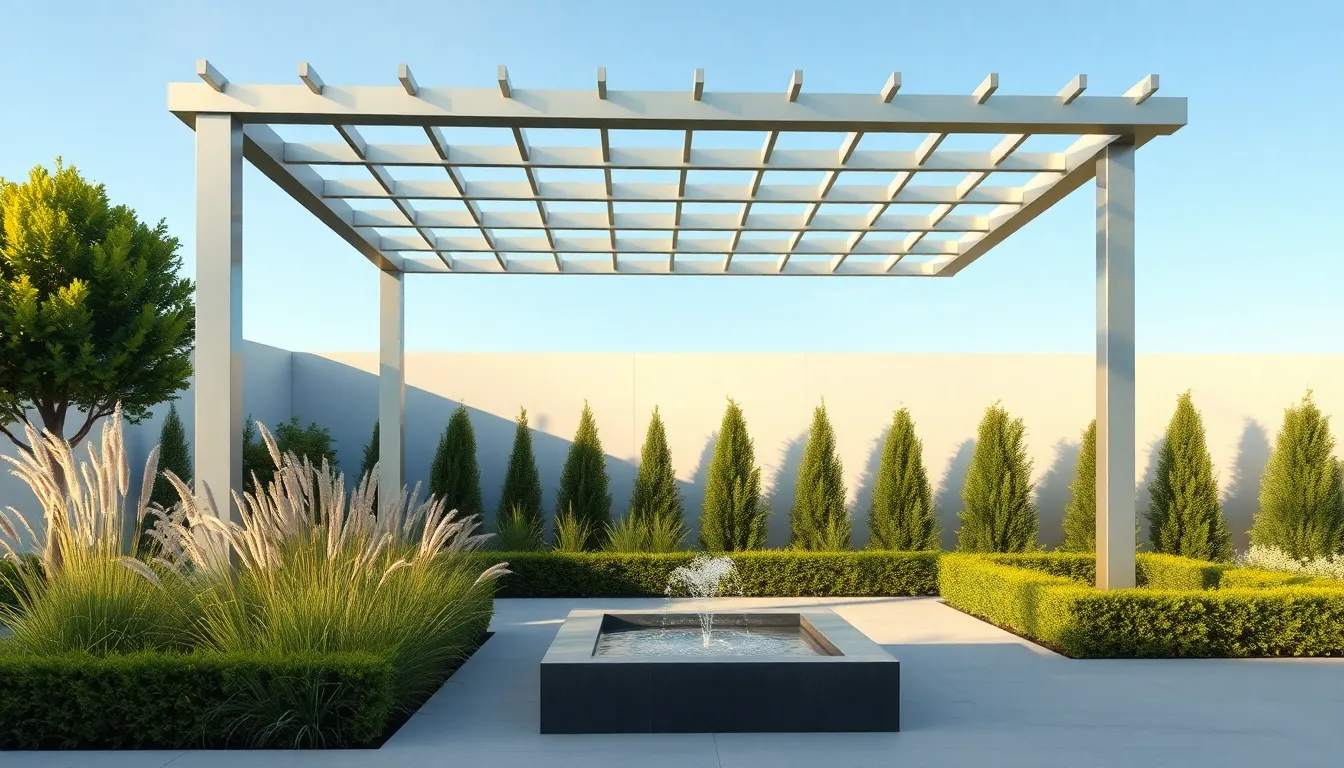
Creating a minimalist garden sanctuary requires precision in both design choices and material selection. Modern pergolas serve as the perfect architectural foundation for achieving this sophisticated outdoor aesthetic.
Choose Clean Lines and Contemporary Materials
Aluminum and stainless steel pergolas deliver the sleek geometric shapes that define contemporary garden design. These materials provide exceptional durability while maintaining the polished appearance essential for modern minimalist spaces. Powder-coated steel options offer additional weather resistance with clean lines that emphasize openness and minimal visual obstruction.
Geometric structures create wide spans of uninterrupted space that feel airy and expansive. We recommend selecting pergolas with clear or translucent roofing materials to maintain natural light flow while providing necessary shelter. Contemporary materials like these require minimal maintenance compared to traditional wood options, making them ideal for busy homeowners seeking low-maintenance elegance.
Wide-span designs eliminate the need for multiple support posts, creating unobstructed sight lines throughout your garden space. Steel and aluminum pergolas can be customized with precise angles and measurements to achieve perfect symmetry in your outdoor design.
Incorporate Geometric Planting Schemes
Symmetrical plant arrangements complement the clean architecture of modern pergolas perfectly. Square or rectangular planting beds positioned at equal distances create visual balance that reinforces the minimalist aesthetic. Ornamental grasses like fountain grass and feather reed grass provide structured geometric forms while adding gentle movement to the space.
Boxwood hedges trimmed into precise rectangular shapes serve as living architectural elements. These evergreen shrubs maintain their geometric form year-round, providing consistent structure to your minimalist garden design. Japanese yews and dwarf Alberta spruces offer additional options for creating clean geometric plant features.
Repetitive planting patterns using identical species create rhythmic visual flow throughout the space. We suggest grouping plants in odd numbers like three or five to achieve natural-looking symmetry. Succulent gardens arranged in geometric containers add textural interest while maintaining the clean minimalist approach.
Add Water Features for Tranquil Sounds
Small fountains positioned strategically near your pergola create soothing background sounds that enhance relaxation. Rectangular or circular water basins with clean edges complement the geometric design principles of modern minimalist gardens. Simple bubbling fountains require minimal maintenance while providing continuous gentle water sounds.
Shallow reflecting pools add visual depth and create peaceful focal points beneath pergola structures. These water features double as design elements that reflect the sky and surrounding plants, creating an illusion of expanded space. Linear water channels connecting different garden areas can guide visitors through your minimalist industry design.
Wall-mounted water features save ground space while providing the tranquil sounds essential for creating a peaceful garden atmosphere. Modern designs in stainless steel or natural stone integrate seamlessly with contemporary pergola materials. Timer-controlled pumps allow you to enjoy water sounds during exact hours while conserving energy and water resources.
Establish a Cottage Garden Paradise with Rustic Wooden Pergolas
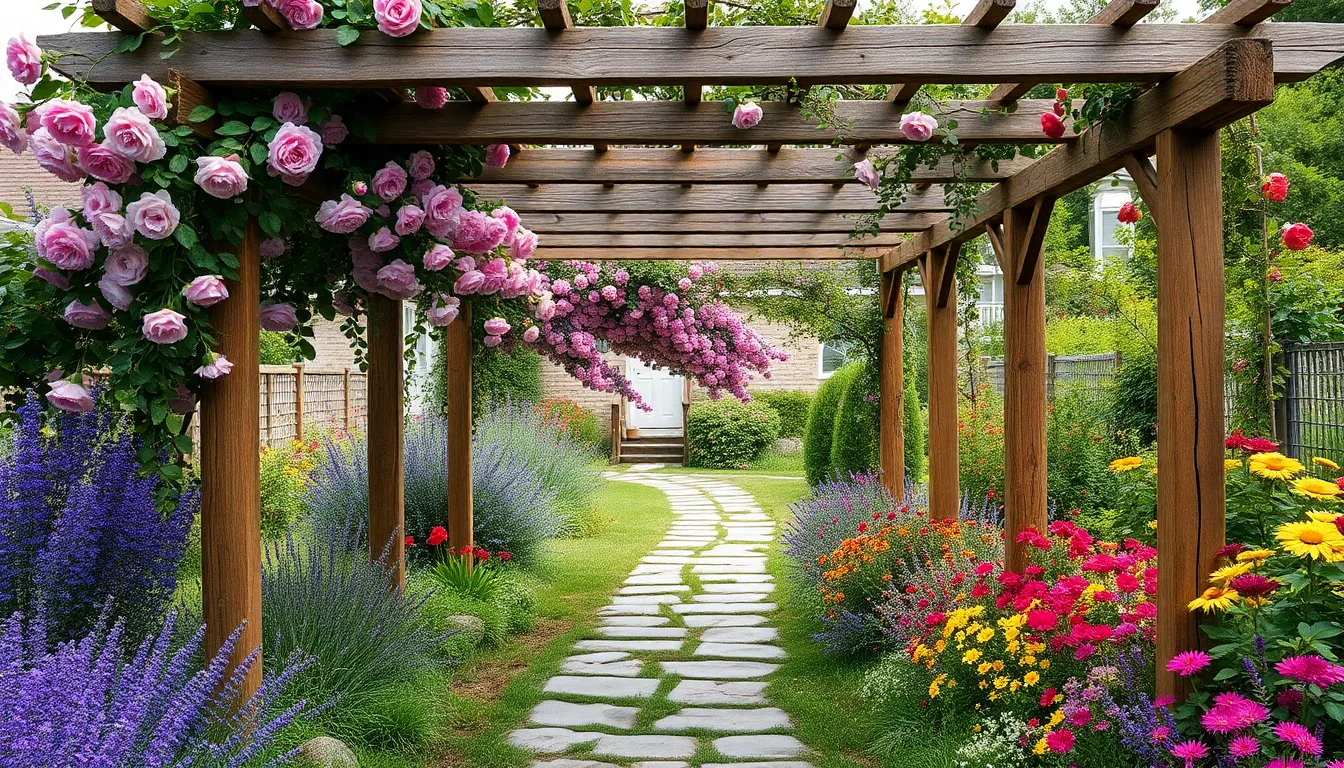
Creating a cottage garden paradise with rustic wooden pergolas brings timeless charm and natural beauty to our outdoor spaces. We can transform ordinary gardens into enchanting retreats that blend seamlessly with nature’s organic patterns.
Select Reclaimed Wood for Authentic Character
Choosing reclaimed wood adds authentic character that perfectly complements our cottage garden aesthetic. We recommend sourcing weathered barn wood or vintage fence materials that showcase natural patina and unique grain patterns. Reclaimed lumber blends seamlessly with natural settings while creating cozy and inviting spaces that feel established rather than newly constructed.
Building with recycled materials reduces environmental impact while providing superior durability compared to fresh lumber. We’ve found that old growth timber often contains natural oils and density that resist weathering better than modern alternatives. Aged wood develops distinctive color variations and textures that enhance the rustic appeal of our pergola structures.
| Wood Type | Durability Rating | Cost Range | Character Features |
|---|---|---|---|
| Reclaimed Barn Wood | 25-30 years | $8-15 per sq ft | Natural patina, unique grain |
| Vintage Cedar | 20-25 years | $6-12 per sq ft | Weather resistance, aromatic |
| Salvaged Oak | 30+ years | $10-18 per sq ft | Dense grain, rich coloring |
Plant Traditional Cottage Garden Flowers
Traditional cottage garden flowers like roses, lavender, and daisies create lush and vibrant atmospheres around our pergola structures. We suggest planting climbing roses that will eventually cascade over the wooden framework, providing natural shade and romantic appeal. English lavender borders offer fragrance and attract beneficial pollinators while requiring minimal maintenance once established.
Cottage gardens thrive with informal planting schemes that appear naturally abundant rather than rigidly structured. We recommend mixing perennial favorites such as hollyhocks, foxgloves, and sweet peas to achieve that quintessential English garden look. These flowering plants create layers of color and texture that complement the rustic wooden elements beautifully.
Selecting plants that bloom in succession ensures continuous color throughout growing seasons. We’ve discovered that combining early spring bulbs with summer perennials and late season asters provides visual interest from March through October. Native wildflowers mixed with traditional varieties create sustainable ecosystems that support local wildlife populations.
Create Informal Pathways with Natural Materials
Natural pathway materials like stone, gravel, and reclaimed wood create seamless connections between our pergola and surrounding garden areas. We prefer using flagstone or natural slate that weathers beautifully and provides stable footing in all seasons. Crushed gravel pathways offer excellent drainage while maintaining the informal cottage garden aesthetic.
Wooden stepping stones cut from the same reclaimed lumber as our pergola create visual continuity throughout the garden design. We recommend spacing stones approximately 18 inches apart to accommodate comfortable walking while allowing ground cover plants to grow between sections. This approach softens hard edges and encourages the naturalized appearance that defines cottage garden style.
Curved pathways feel more organic than straight lines and invite leisurely strolling through our garden paradise. We design winding routes that reveal different garden vignettes and create a sense of discovery as visitors explore the space. Natural materials complement the rustic pergola while highlighting various garden features along the journey.
Construct a Vegetable Garden Haven with Functional Pergola Systems
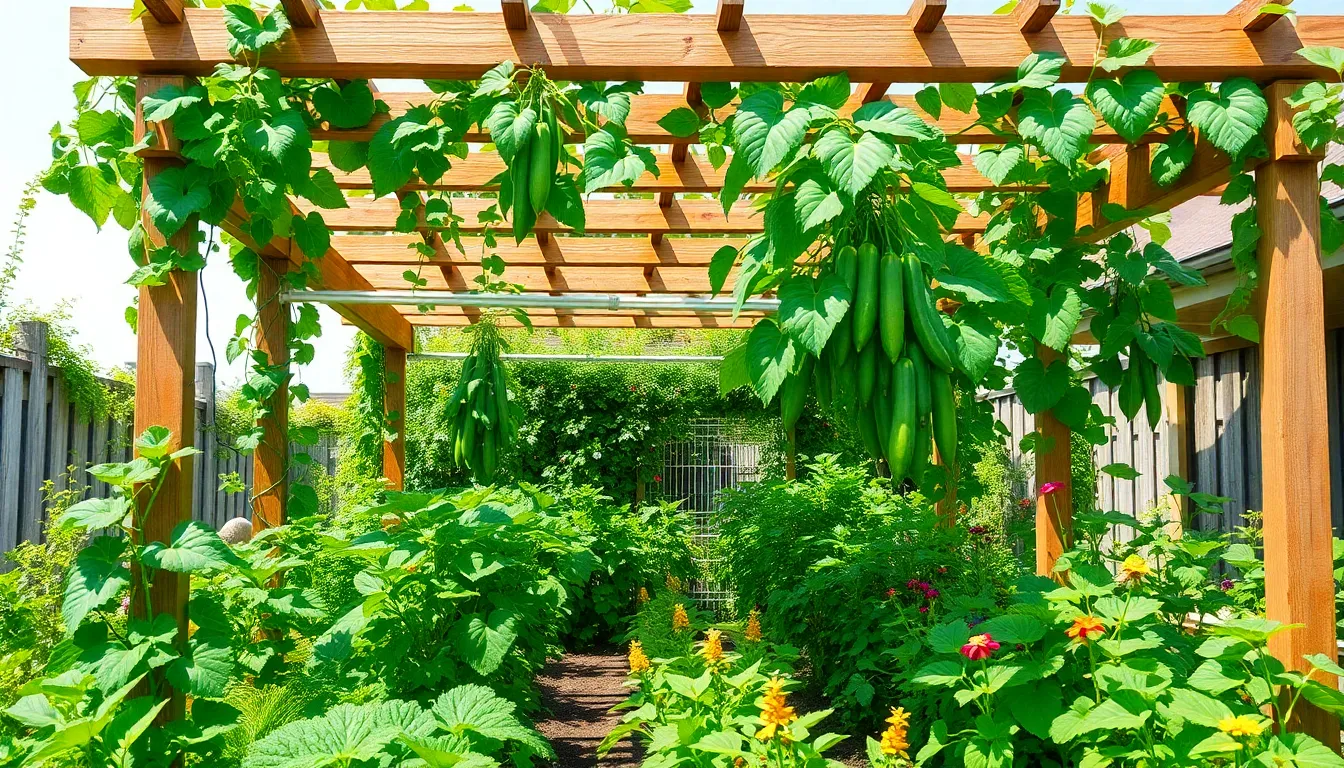
We can transform our pergola from a decorative element into a productive agricultural system by incorporating vegetable growing capabilities. Combining functionality with beauty, our pergola becomes the backbone of an efficient and visually appealing food production space.
Design Trellises for Climbing Vegetables
Wooden trellises attached directly to our pergola posts provide excellent support for climbing vegetables like peas, beans, and cucumbers. Metal options offer increased durability and can withstand heavier vine loads throughout multiple growing seasons. Designing these trellis systems to fit seamlessly within our pergola’s existing structure creates a cohesive look while maximizing vertical growing space.
Selecting a diverse mix of climbing vegetables and companion flowers adds both productivity and visual interest to our garden design. Pole beans can climb alongside morning glories, while cucumber vines intertwine with nasturtiums for natural pest control. Planning the placement of different climbing plants ensures adequate sunlight reaches each variety while creating an attractive tapestry of colors and textures.
Custom trellis configurations allow us to accommodate various plant heights and growth patterns throughout the season. Lower sections work well for compact climbing varieties, while upper areas support vigorous growers that reach toward the pergola’s top beams. Installing removable trellis panels makes seasonal cleaning and maintenance more manageable.
Install Irrigation Systems Within the Structure
Drip irrigation systems integrated into our pergola framework deliver water directly to plant roots while minimizing waste and evaporation. Soaker hoses can be threaded along the pergola’s base and vertical supports to provide consistent moisture for both climbing and ground level plants. These efficient watering methods reduce our manual labor while ensuring optimal plant health.
Water lines concealed within the pergola’s structure maintain the aesthetic appeal while providing functional irrigation coverage. Installing shut off valves at different zones allows us to customize watering schedules for various plant types and their exact moisture requirements. Timer controlled systems automate the watering process, making garden maintenance more convenient.
Collecting rainwater through gutters attached to the pergola’s roof provides an eco friendly irrigation source during dry periods. Storage tanks positioned strategically around the structure supply gravity fed water distribution when municipal water restrictions apply. This sustainable approach reduces our environmental impact while maintaining garden productivity.
Plan for Seasonal Crop Rotation and Support
Rotating different vegetable families through our pergola supported growing areas prevents soil depletion and reduces pest buildup over time. Spring plantings of cool season crops like peas give way to summer beans and fall cucumbers, ensuring continuous production throughout the growing season. This systematic approach maintains soil fertility while maximizing our harvest potential.
Supporting various plant types requires adjustable trellis systems that accommodate seasonal changes in our crop selection. Heavy fruiting plants like winter squash need stronger structural support than lightweight leafy greens during their respective growing periods. Installing reinforcement points throughout the pergola allows us to add temporary supports when needed.
Stone and brick bases incorporated into our pergola design provide permanent planting areas that complement seasonal rotation plans. These raised beds improve drainage while creating defined spaces for different crop families during rotation cycles. Adding compost and organic matter between seasons maintains soil health and supports vigorous plant growth year after year.
Develop a Zen Garden Sanctuary with Japanese-Inspired Pergolas
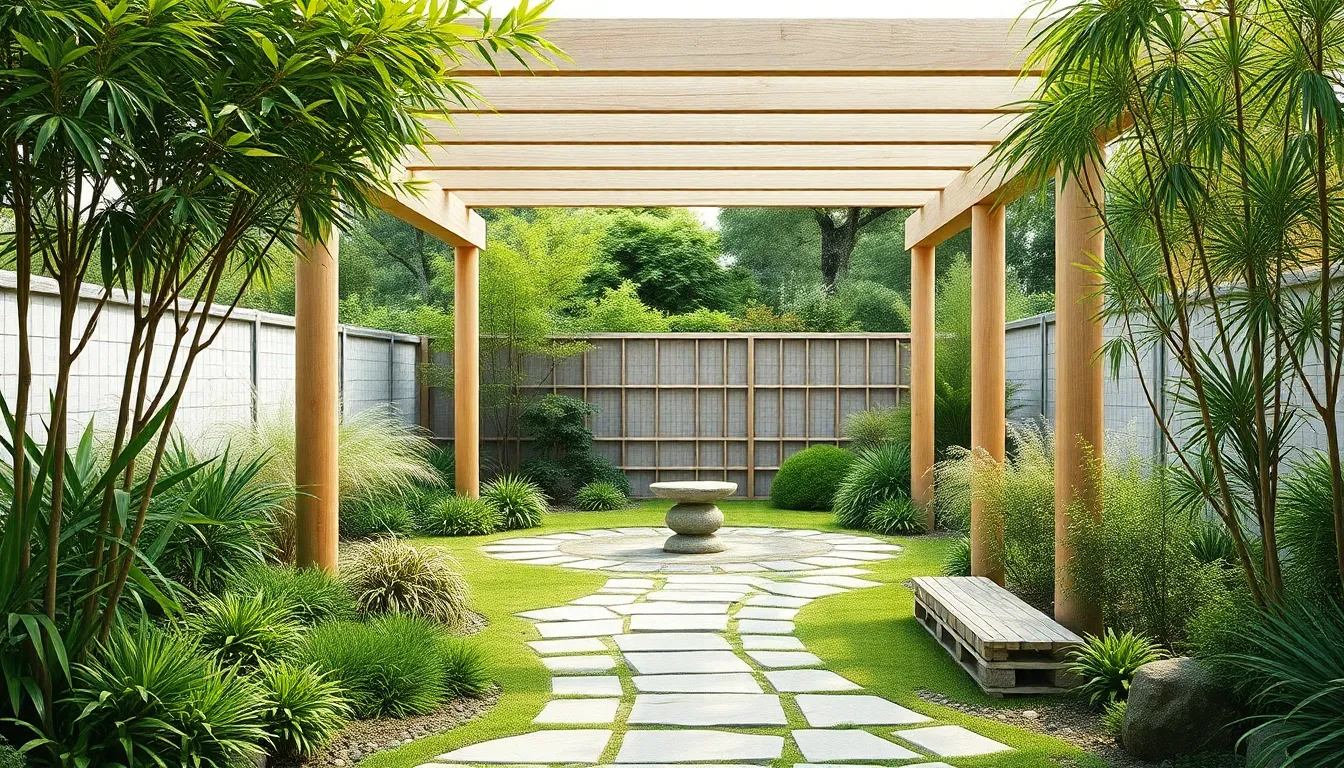
Transform your outdoor space into a tranquil retreat by incorporating simple lines and light wood that define authentic Japanese design. These thoughtfully designed structures create peaceful environments perfect for reflection and relaxation.
Incorporate Bamboo and Natural Wood Elements
Bamboo integration brings traditional Japanese aesthetics to your pergola design while offering exceptional durability and natural beauty. We recommend using bamboo as accent panels or screening elements to create privacy without blocking airflow. Cedar and cypress wood provide excellent structural foundations due to their natural resistance to rot and insects, ensuring your pergola withstands weather conditions for years.
Natural wood selection matters significantly for longevity and appearance. Cedar offers rich color variations that deepen over time, while cypress provides superior moisture resistance in humid climates. Both materials complement bamboo accents beautifully and require minimal maintenance when properly treated.
Create Asymmetrical Balance in Your Design
Asymmetrical layouts embody the core principles of Japanese garden design, creating visual interest through intentional imbalance. Position your pergola off center within the garden space, then balance this placement with strategically located plants, stones, or water features. We suggest grouping elements in odd numbers to achieve harmony without perfect symmetry.
Plant placement around the pergola should follow the rule of thirds, with taller elements like ornamental grasses positioned at varying distances from the structure. Stone arrangements work best when clustered in groups of three or five, creating natural focal points that draw the eye throughout the space.
Add Meditation Spaces and Stone Features
Meditation areas beneath or adjacent to your pergola provide dedicated spaces for contemplation and mindfulness practices. Create comfortable seating arrangements using low wooden benches or traditional tatami mats positioned to face garden views. We recommend incorporating a small side table for tea ceremonies or personal items during meditation sessions.
Stone pathways connecting your pergola to other garden areas should follow gentle curves rather than straight lines, encouraging slow, mindful movement through the space. Japanese stone lanterns placed along these paths provide soft lighting for evening use while maintaining authentic design elements. Water features like small fountains or bamboo water spouts add soothing sounds that enhance the meditative atmosphere surrounding your zen garden sanctuary.
Install a Poolside Paradise with Pergola Shade Structures
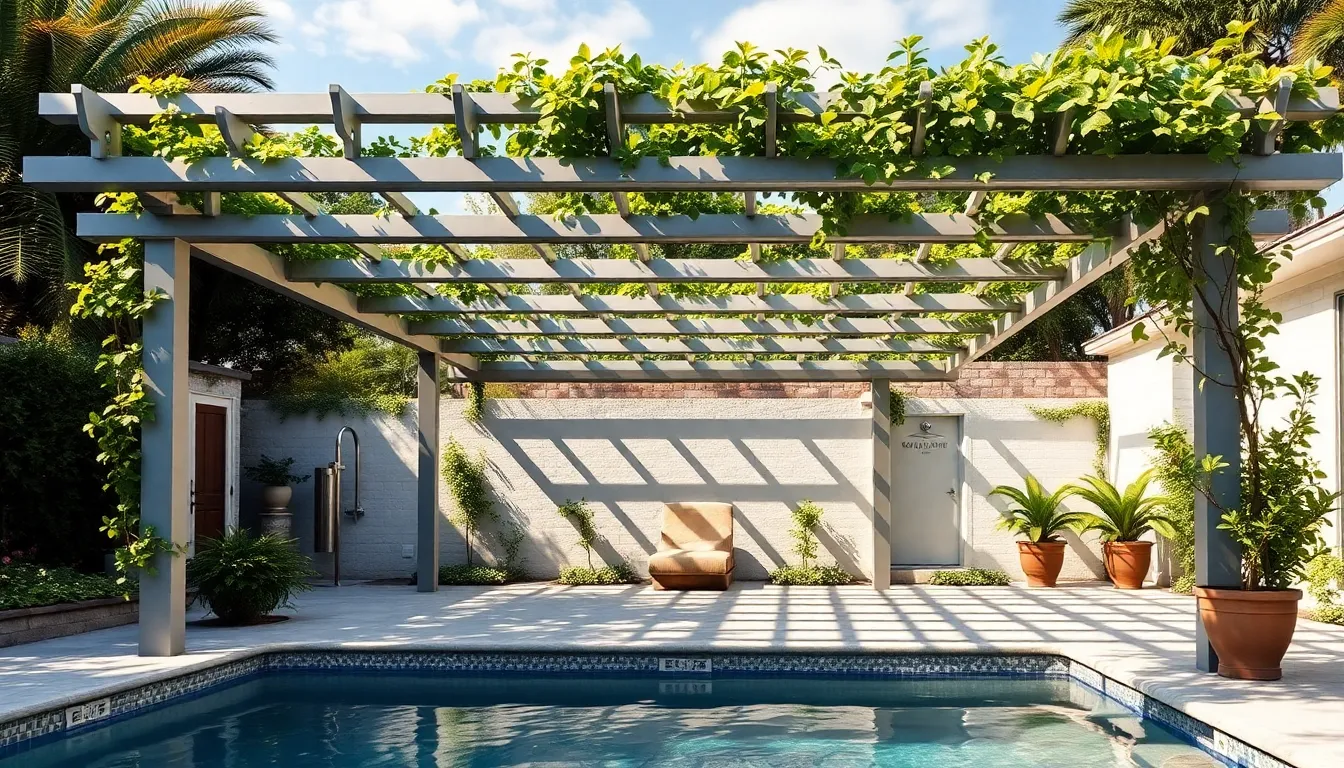
Creating a poolside pergola transforms your swimming area into a luxurious outdoor retreat. These structures provide essential shade while adding architectural interest to your pool industry.
Choose Chlorine-Resistant Materials and Finishes
Selecting the right materials prevents costly replacements and maintenance headaches around your pool. Chlorine exposure breaks down many traditional building materials, making material choice critical for longevity. Aluminum pergolas offer excellent chlorine resistance and never rust, making them ideal for poolside installations. Powder-coated finishes on metal structures provide an extra layer of protection against chemical damage.
Treated cedar and redwood naturally resist chlorine while maintaining their beautiful appearance. These premium woods contain natural oils that repel moisture and chemicals, extending their lifespan in pool environments. Marine-grade stainless steel hardware prevents corrosion from constant exposure to pool chemicals and humidity.
Vinyl pergolas require minimal maintenance and completely resist chlorine damage. Modern vinyl materials look like wood but eliminate the need for annual staining or sealing. High-quality PVC pergolas maintain their color and structural integrity for decades around pools.
Design for Privacy and Wind Protection
Strategic placement of your pergola creates natural barriers against wind and prying eyes. Position your structure to block prevailing winds while maintaining access to pool areas. Lattice panels integrated into pergola sides provide partial privacy without completely blocking airflow.
Climbing plants create living privacy screens that improve over time. Evergreen vines like star jasmine or Confederate jasmine maintain year-round coverage while adding fragrance to your pool area. Fast-growing options like clematis or morning glory quickly establish privacy barriers.
Retractable curtains offer adjustable privacy and wind protection when needed. Weather-resistant outdoor fabrics can be drawn for complete privacy during pool parties or opened for unobstructed views. Install curtain tracks within the pergola framework for seamless integration.
Integrate Outdoor Shower and Changing Areas
Connecting shower facilities to your pergola creates a complete poolside experience. Position outdoor showers adjacent to the pergola to provide privacy while maintaining easy pool access. Concrete pads with proper drainage prevent water accumulation around the structure.
Changing areas within or near the pergola eliminate trips inside the house. Install privacy screens or use strategic plantings to create discrete changing spaces. Built-in benches provide convenient seating for changing clothes or storing pool accessories.
Plumbing integration during pergola construction saves money and improves aesthetics. Run water lines through pergola posts to minimize visible pipes and create clean installations. Hot water connections make outdoor showers comfortable throughout swimming seasons.
Create a Year-Round Garden Room with Enclosed Pergola Designs
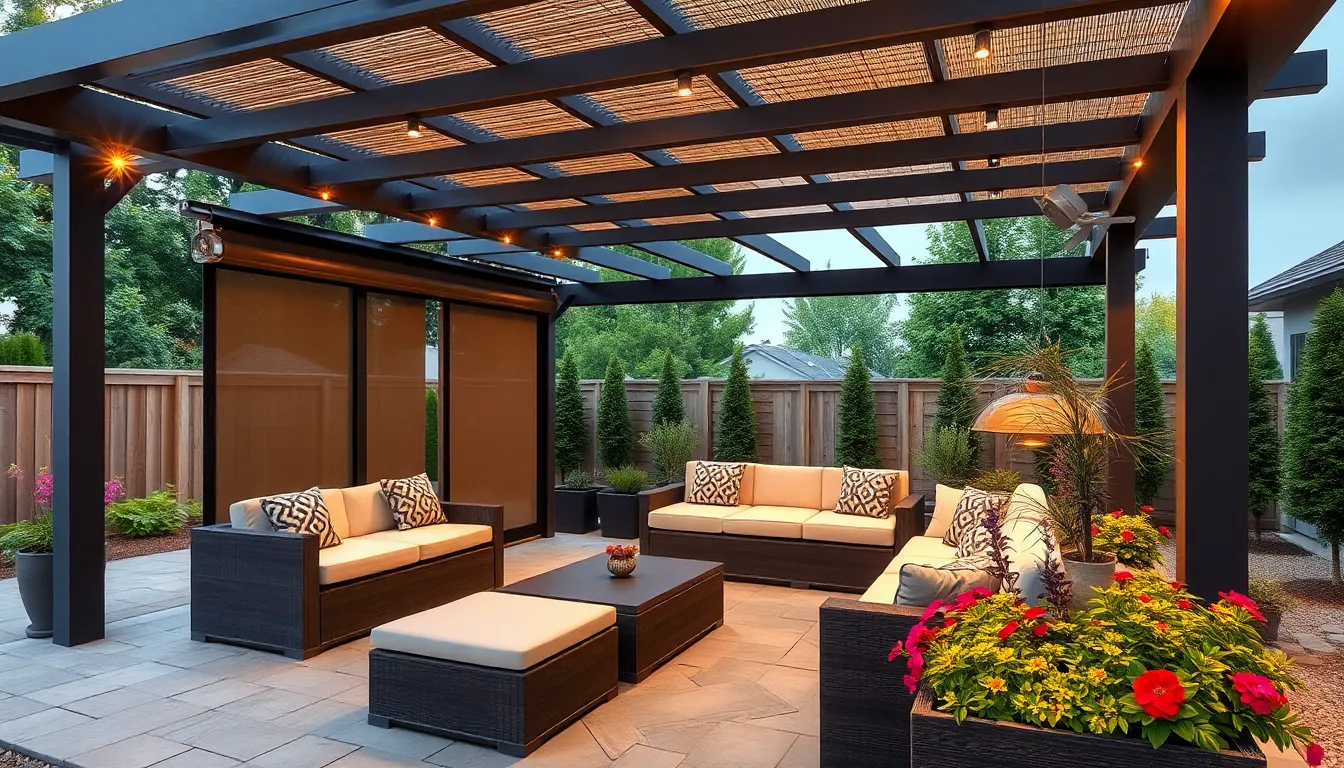
Transforming your outdoor pergola into a functional year-round garden room extends your living space beyond traditional seasonal limitations. We’ll explore the essential elements that make enclosed pergola designs both practical and beautiful throughout all seasons.
Add Retractable Walls and Roof Panels
Retractable walls and roof panels offer the ultimate flexibility for your enclosed garden room. These adaptable features allow you to open or close your space depending on weather conditions and privacy needs, maximizing outdoor living throughout every season. Many current designs integrate removable panels that provide seamless transitions from fully open pergolas to completely enclosed garden rooms.
Manual and automated systems both deliver excellent results for controlling sunlight, ventilation, and protection from rain or wind. Louvers can be adjusted by hand for a more traditional approach, while remote-controlled and smart home integrated answers offer modern convenience. Fabric covers provide softer aesthetics and can be motorized for easy operation during changing weather conditions.
Smart integration capabilities allow you to control your pergola’s openings through smartphone apps or voice commands. This technology ensures your garden room adapts instantly to unexpected weather changes, protecting your furniture and creating comfortable environments year round.
Install Heating and Cooling Answers
Heating and cooling answers are essential for maintaining year-round comfort in your enclosed garden room. Overhead radiant heaters provide targeted warmth during cooler months, while ceiling fans ensure proper air circulation during warmer periods. The Pergola X and similar models feature built-in heating and cooling systems that maintain comfortable temperatures regardless of outdoor conditions.
HVAC integration offers comprehensive climate control for larger enclosed spaces. These systems can be designed to blend seamlessly with your pergola’s aesthetic while providing consistent temperature regulation. Always verify manufacturer guidelines when installing heating or fire features to ensure proper safety compliance.
Zoned climate control allows different areas of your garden room to maintain separate temperature settings. This approach maximizes energy efficiency while ensuring every corner of your outdoor space remains comfortable for extended use.
Design Built-In Storage and Seating
Built-in storage and seating contribute significantly to creating a functional and inviting garden room atmosphere. Benches can be seamlessly integrated into your pergola structure, providing comfortable seating while incorporating hidden storage compartments underneath. Cupboards and shelving units blend with the overall design while minimizing visual clutter and maximizing usable space.
Banquettes encourage social gatherings and extend the usability of your outdoor area throughout different seasons. These integrated seating answers can include weather-resistant cushions and built-in side tables for beverages and dining accessories.
Strategic placement of storage elements ensures your garden room remains organized and welcoming. Built-in planters can serve dual purposes by providing storage space while housing seasonal plants that enhance your enclosed pergola’s natural beauty.
Plan a Multi-Level Garden with Terraced Pergola Features
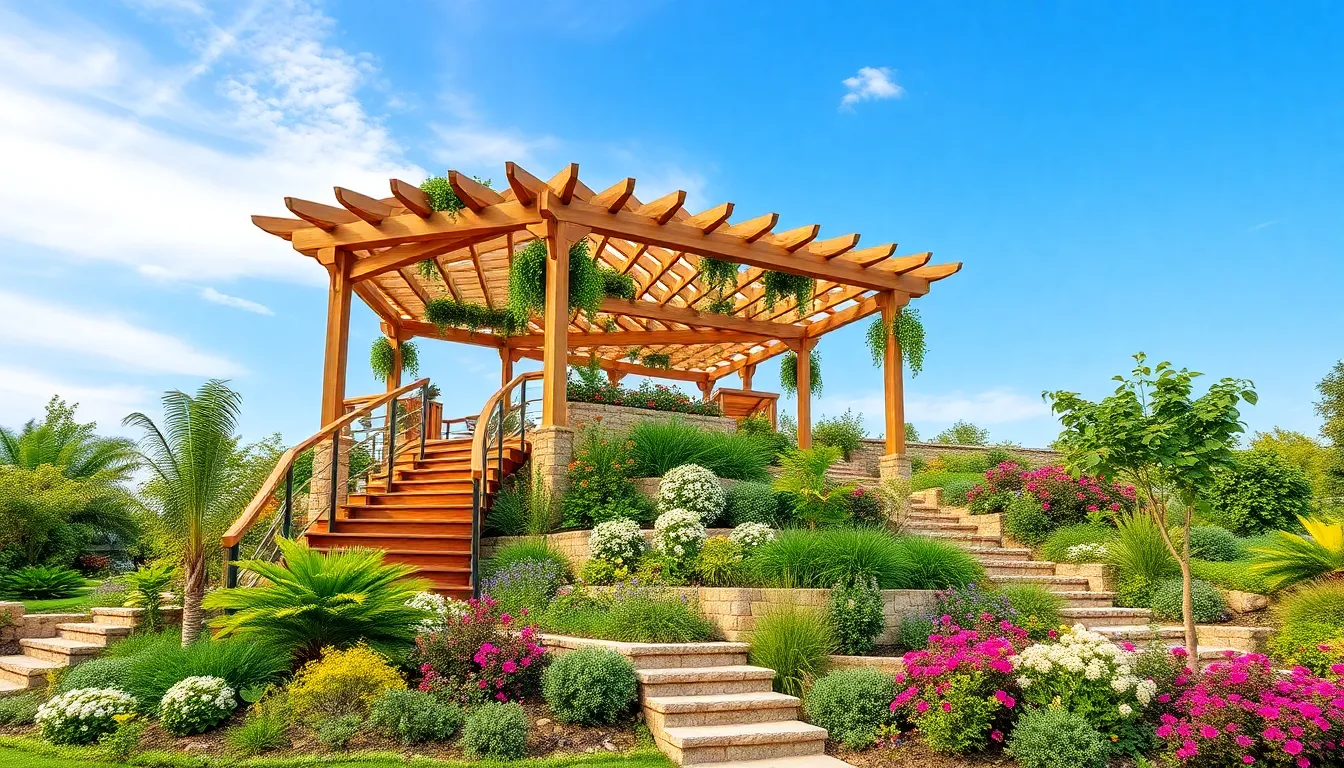
Multi-level gardens with terraced pergola features maximize space efficiency while creating stunning visual depth across sloped landscapes. We’ll guide you through the essential planning steps to transform challenging terrain into a functional and beautiful outdoor sanctuary.
Work with Sloped Terrain and Elevation Changes
Terraced pergolas adapt beautifully to slope changes, allowing us to create efficient use of space while maintaining visually appealing designs. We start by evaluating the natural grade of our terrain and identifying optimal locations for each pergola level. Traditional three-tiered pergola designs work exceptionally well as standalone structures, providing multiple zones for socializing and shade across different elevations.
Leveling becomes crucial when working with sloped terrain, as each garden level must remain stable and secure to support both the pergola weight and user activity. We recommend creating distinct platforms at varying heights, with each level serving a exact purpose in our overall garden design. Two-level graduated pergolas offer excellent answers for covering walkways and porches, positioning the lower level at entrance points and the higher level over deck areas.
Mixed shape pergola designs combine different geometric forms, such as square centers with triangular or circular attachments, helping us work with natural terrain contours. We can integrate these varied shapes to follow the land’s natural flow while creating interesting architectural elements. Professional grading ensures that each terraced section provides adequate foundation support for our pergola structures.
Create Connecting Staircases and Walkways
Staircase design integration becomes essential for connecting different garden levels, requiring sturdy construction that complements our pergola aesthetics. We focus on creating transitions that feel natural and inviting, using materials that match our overall garden theme. Stone, brick, and wood pathways create seamless connections between terraced levels while improving the visual appeal of our pergola garden.
Walkway materials should complement both the garden industry and pergola structure, creating cohesive design flow throughout our multi-level space. We select materials based on durability, slip resistance, and aesthetic compatibility with our chosen pergola style. Natural stone pavers work particularly well for connecting different elevation points, providing stable footing and timeless appeal.
Safety considerations guide our staircase planning, ensuring adequate width, proper rise and run ratios, and secure handrails where needed. We design connecting pathways with gentle curves when possible, creating more natural movement patterns between our terraced pergola areas. Lighting integration along walkways and staircases extends usability into evening hours while highlighting our garden’s architectural features.
Design Drainage Answers for Each Level
French drains provide effective water management across different garden levels, preventing erosion and water damage to our pergola foundations. We install these drainage systems strategically to capture and redirect water flow away from structural elements. Proper drainage planning protects both our investment and ensures long-term stability of our terraced garden design.
Slope and grading considerations prevent water accumulation at each level, with proper drainage directing water away from pergola posts and seating areas. We ensure that each terraced section has adequate drainage outlets, preventing standing water that could damage plants or create safety hazards.
| Drainage Solution | Best For | Maintenance Level |
|---|---|---|
| French Drains | Managing water flow across levels | Low |
| Grading & Slopes | Preventing water accumulation | Minimal |
| Retaining Wall Drains | Supporting terraced structures | Medium |
Water management systems work most effectively when integrated during initial construction phases, allowing us to create seamless answers that don’t interfere with our pergola aesthetics. We position drainage elements to remain hidden while providing maximum effectiveness across all terraced levels.
Conclusion
We’ve explored countless ways to transform your outdoor space with beautiful pergola designs that suit every style and budget. From romantic rose-covered retreats to modern minimalist structures each approach offers unique opportunities to create your perfect garden sanctuary.
The key to success lies in choosing designs that complement your existing industry while meeting your exact needs. Whether you’re planning a cozy dining area or a year-round garden room the right pergola can dramatically enhance both functionality and beauty.
Remember that the best pergola projects start with careful planning and attention to your local climate. By selecting appropriate materials and plants for your region you’ll create an outdoor space that thrives for years to come.
Your dream garden with a stunning pergola is within reach – it’s time to start building the outdoor paradise you’ve always wanted.
Frequently Asked Questions
What are the main benefits of adding a pergola to my garden?
Pergolas transform ordinary gardens into extraordinary outdoor retreats by combining functionality with aesthetic appeal. They provide structure for defining spaces, support climbing plants, create shaded areas for dining and relaxation, and serve as beautiful backdrops for outdoor living. Additionally, pergolas increase property value while offering versatile design options to suit various garden styles.
Which materials are best for pergola construction?
Weather-resistant materials ensure durability and minimal maintenance. Cedar and redwood offer natural beauty and rot resistance, while aluminum provides modern aesthetics with zero maintenance. Vinyl is cost-effective and long-lasting, and stainless steel suits contemporary designs. For poolside installations, choose chlorine-resistant materials like treated cedar, aluminum, or vinyl.
How do I choose the right climbing plants for my pergola?
Select plants based on your climate zone and desired aesthetic. For romantic gardens, choose Eden roses for temperate zones or Lady Banks roses for warmer climates. Mediterranean gardens benefit from grapevines, while cottage gardens thrive with climbing roses and lavender. Consider the plant’s weight and growth pattern when planning support structures.
What lighting options work best for pergola spaces?
String lights create warm, inviting atmospheres perfect for evening gatherings. Pendant fixtures provide focused lighting for dining areas, while solar-powered options offer eco-friendly illumination. For pathways, consider low-voltage landscape lighting. Incorporate dimmers for adjustable ambiance and ensure all electrical installations are weather-resistant and professionally installed.
Can pergolas be used for vegetable gardening?
Yes, pergolas make excellent structures for vertical vegetable gardens. Install trellises for climbing vegetables like peas, beans, and cucumbers. Integrate irrigation systems within the structure for efficient watering. Use raised planting areas with stone or brick bases, and practice seasonal crop rotation to maximize harvest potential and soil health.
How do I maintain my pergola throughout the seasons?
Regular maintenance depends on your material choice. Wood pergolas need annual staining or sealing, inspection for rot or pest damage, and immediate repair of loose hardware. Metal pergolas require occasional cleaning and rust prevention. All pergolas benefit from regular vine pruning, debris removal, and checking support systems for heavy climbing plants.
What’s the difference between open and enclosed pergola designs?
Open pergolas provide partial shade while maintaining airflow and an outdoor feel. Enclosed pergolas feature retractable walls and roof panels, creating year-round garden rooms with weather protection. Enclosed designs can incorporate heating, cooling, and built-in storage but require more substantial construction and higher investment costs.
How do I design a pergola for sloped terrain?
Terraced pergola designs maximize sloped landscapes by creating distinct levels connected with staircases and walkways. Evaluate terrain stability, plan proper drainage with French drains, and ensure each level has adequate support. Use retaining walls where necessary and select materials that complement the natural landscape while providing structural integrity.

